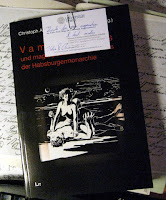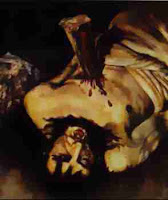In the last few days, I've stumbled on a few items which challenge my views on vampire 'history'. For instance, I thought the 1991 role-playing game—
Vampire: the Masquerade—was the first attempt at linking
Cain with vampires.
Cain—son of Adam and Eve—murdered his brother, Abel, and was subsequently cursed by God: 'And now art thou cursed from the earth, which hath opened her mouth to receive thy brother's blood from thy hand; When thou tillest the ground, it shall not henceforth yield unto thee her strength; a fugitive and a vagabond shalt thou be in the earth' (Genesis 4: 11–12).
After Cain protests his punishment as something more than he can bare; fearing he could be killed in turn, he is 'protected' thusly: 'And the LORD said unto him, Therefore whosoever slayeth Cain, vengeance shall be taken on him sevenfold. And the LORD set a mark upon Cain, lest any finding him should kill him' (v. 15).
Cain's curse and vagabond status morphed into vampirism within Vampire: the Masquerade's mythos. Indeed, according to the game's backstory, he's the world's first vampire.
As it turns out, the link between vampires and Cain was made much earlier. More than a hundred years before,
J. Theodore Bent's assessment of the Greek Βρονκόλακες mentioned: 'In Karpathos they call these beings "Cains," affirming that Cain, who slaughtered Abel on his death, became the first wandering vampire.'
1
Not only that, but there's also a link between them and the vampire 'species' featured in the
previous post: 'They here mix them up with another species of hobgoblin, evil spirits formed like men, with asses' or goats' feet, which appear on the earth for ten days only, from Christmas to Epiphany, during which time they subsist, like the Amazons of old, on snakes and lizards.'
2
Our modern conception of vampires stems largely from
Bram Stoker's
Dracula (1897). One notable aspect includes vampires turning into bats. Everyone knows that trope, but they probably
don't know it originated with Stoker's novel—or did it?
Earlier this year, I found a pre-
Dracula reference to vampires turning into bats in an 1892 newspaper article. That is, an article
reproduced in a book by
Christopher Rondina. But, I had my suspicions and
double-checked the original source. It turned out to be a hoax, as its author
confirmed: 'As an avid vampire fan, I was also disappointed to see the absence of bats in the original folklore, and I inserted the reference into the 1892 article as a vanity "enhancement" for my own satisfaction.'
No need for disappointment. I found a vampires-into-bats reference pre-dating his own 'enhancement'—by nearly 20 years: 'The belief that human beings were sometimes changed into the bats called vampyres is found in India, and was also Magian.'
3 This isn't
quite the same thing, though. The passage refers to people changing into
vampire bats, not that they were vampires, per se. However, I suspect that, too, is a misnomer: vampire bats are not native to India.
The article's anonymous author may have conflated vampire bats and their supposed morphic capabilities with a popular retelling of
Baital Pachisi—
Richard F. Burton's
Vikram and the Vampire; or, Tales of Hindu devilry (1870). The so-called 'vampire'—
baital or
vetala—is actually an 'evil spirit which animates dead bodies'.
4 No mention of blood-drinking.
The bat connection's found in its appearance: 'Its body was thin and ribbed like a skeleton or a bamboo framework, and as it held on to a bough, like a flying fox,'
5 on which Burton elaborates, 'A large kind of bat ; a popular and silly Anglo-Indian name.'
6
Far from vampiric, the
flying fox's diet is given away by its other name—fruit bats. 'They live in the tropics and subtropics of Asia (including the Indian subcontinent)', whereas
vampire bats are notably smaller and found in 'the Americas, ranging from Mexico to Brazil, Chile, and Argentina.'
What's the connection between flying foxes and vampires? The Indian Flying-fox is a member of the
Pteropus vampyrus species.
A popular theory explaining the origin of the vampire belief concerns plagues. One proponent,
Olga Hoyt, wrote, 'A more cogent reason for the spread of vampirism throughout Europe, beginning in the Middle Ages, however, was the was the terrible plague [
Black Death] that began in the thirteenth century and lasted until the eighteenth.'
7
Vampirism acted as a sort of supernatural epidemic, spreading from village to village, as seen in the
Plogojowitz and
Paole cases. It's not hard to see parallels, but few have established
direct connections between vampire belief and the plague.
Well, I found one. A missing link.
The Daily Gazetteer (6 September 1738)
8 covered the movement of Turkish troops 'posted near Inharlick' towards Raskow, to head off a Russian contingent marching towards a strategically important river. Here's what happened next:
Podolia, no longer a Polish territory, 'is an historical region in the west-central and south-west portions of present-day Ukraine, corresponding to Khmelnytskyi Oblast and Vinnytsia Oblast.'
1. JT Bent, ‘Personification of the mysterious amongst the modern Greeks’, The National Review, April, 1887, p. 233, 26 December 2011, retrieved from British Periodicals.↩
3. ‘Demonology’, Fraser’s Magazine, December, 1872, p. 701, viewed 27 December 2011, retrieved from British Periodicals.↩
4. RF Burton (adapt.), Vikram and the Vampire; or, Tales of Hindu devilry, Longmans, Green, and Co., London, 1870, p. xiii, viewed 20 August 2010, retrieved from Internet Archive.↩
7. O Hoyt, Lust for blood: the consuming story of vampires, Stein and Day, New York, 1984, p. 56.↩
8. 'Yesterday arrived mail due from Holland', The Daily Gazetteer, 6 September 1738, p. [2592], viewed 27 December 2011, retrieved from British Periodicals. The section is titled 'Warsaw, Aug. 19. O. S.'↩





















